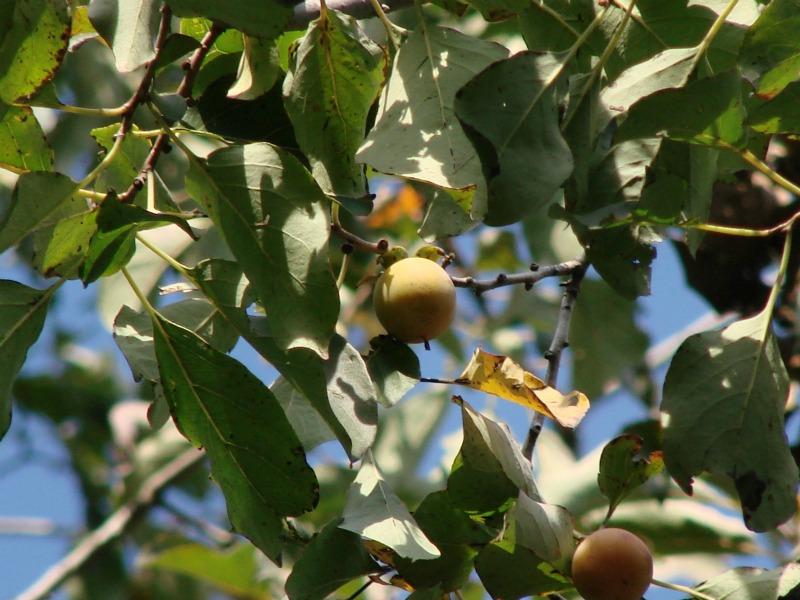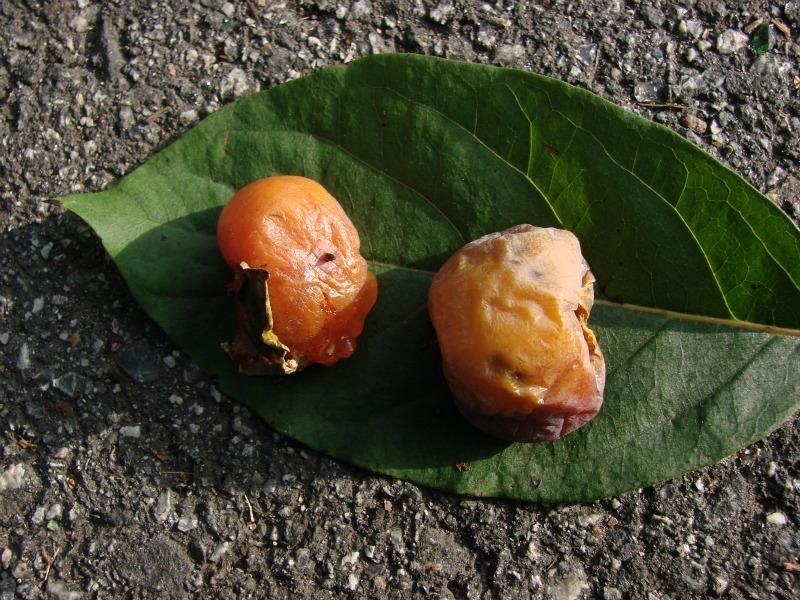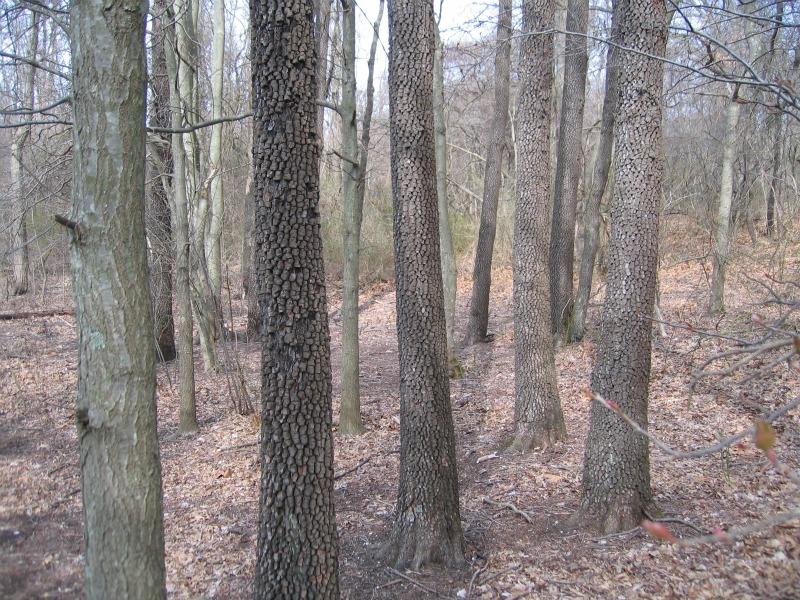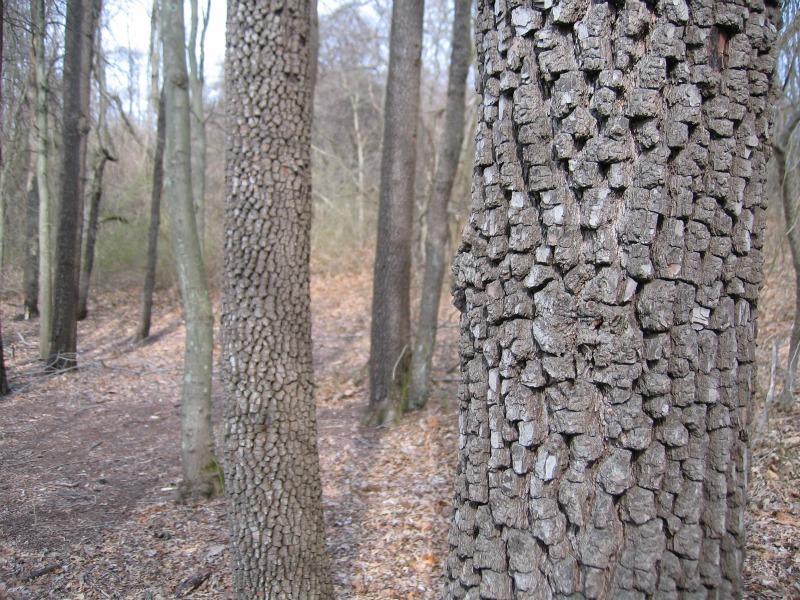Persimmon
Diospyros virginiana L.
- Class
- Dicotyledoneae (Dicots)
- Family
- Ebenaceae
- State Protection
- Threatened
Listed as Threatened by New York State: likely to become Endangered in the foreseeable future. For animals, taking, importation, transportation, or possession is prohibited, except under license or permit. For plants, removal or damage without the consent of the landowner is prohibited.
- Federal Protection
- Not Listed
- State Conservation Status Rank
- S2
Imperiled in New York - Very vulnerable to disappearing from New York due to rarity or other factors; typically 6 to 20 populations or locations in New York, very few individuals, very restricted range, few remaining acres (or miles of stream), and/or steep declines.
- Global Conservation Status Rank
- G5
Secure globally - Common in the world; widespread and abundant (but may be rare in some parts of its range).
Summary
Did you know?
The scientific name Diospyros can be translated to "Jupiter's grain," and what God wouldn't want to eat this delicious fruit? This species is one of only two temperate members of the tropical ebony family, the other one being Diospyros texana. The fruit from a third species, Diospyros kaki, is known as the Chinese persimmon and can sometimes be found in supermarkets, especially on the West Coast (Wikipedia contributors).
State Ranking Justification
There are 13 existing populations, but only two of these have over 100 stems. Most of them are small groups of trees in highly developed areas. There are 15 historical occurrences, mostly from the New York City and western Long Island area, where many of them can be considered extirpated.
Short-term Trends
The population seems stable, but there has not been a lot of recent survey work to see if many of the small populations remain.
Long-term Trends
While some populations have become extirpated on western Long Island and Staten Island, new populations have also been found and the overall number of populations has remained about the same.
Conservation and Management
Threats
Most populations are found in small natural areas surrounded by development, so they are threatened by invasive species, improper management of the habitat, and direct development.
Conservation Strategies and Management Practices
Trees need to be protected from direct destruction, and a natural buffer needs to be maintained around them to encourage regeneration.
Habitat
Habitat
In New York, native persimmon populations occur in a variety of forested habitats on Long Island and in New York City. They have been found in coastal oak-hickory forests, in swampy woods with blackgum, red maple, and spicebush, and along the margin of coastal ponds and wet depressions (New York Natural Heritage Program 2010). Forests, seasonally flooded bottomlands, dry ridgetops, abandoned agricultural land (FNA 2009). Mostly in dry woods (Gleason and Cronquist 1991).
Associated Ecological Communities
- Coastal oak-hickory forest
(guide)
A hardwood forest with oaks and hickories codominant that occurs in dry, well-drained, loamy sand of knolls, upper slopes, or south-facing slopes of glacial moraines of the Atlantic Coastal Plain.
- Coastal plain pond
(guide)
The aquatic community of the permanently flooded portion of a coastal plain pond with seasonally, and annually fluctuating water levels. These are shallow, groundwater-fed ponds that occur in kettle-holes or shallow depressions in the outwash plains south of the terminal moraines of Long Island, and New England. A series of coastal plain ponds are often hydrologically connected, either by groundwater, or sometimes by surface flow in a small coastal plain stream.
- Mowed lawn with trees
Residential, recreational, or commercial land in which the groundcover is dominated by clipped grasses and forbs, and it is shaded by at least 30% cover of trees. Ornamental and/or native shrubs may be present, usually with less than 50% cover. The groundcover is maintained by mowing and broadleaf herbicide application.
- Red maple-hardwood swamp
(guide)
A hardwood swamp that occurs in poorly drained depressions, usually on inorganic soils. Red maple is usually the most abundant canopy tree, but it can also be codominant with white, green, or black ash; white or slippery elm; yellow birch; and swamp white oak.
- Successional old field
A meadow dominated by forbs and grasses that occurs on sites that have been cleared and plowed (for farming or development), and then abandoned or only occasionally mowed.
Associated Species
- Acer rubrum
- Clethra alnifolia (coastal sweet-pepperbush)
- Cuscuta polygonorum (smartweed dodder)
- Fallopia japonica
- Hibiscus syriaca
- Ilex opaca
- Juglans nigra (black walnut)
- Lindera benzoin (spicebush)
- Nyssa sylvatica (black-gum, sour-gum)
- Osmunda cinnamomea
- Podophyllum peltatum (may-apple)
- Quercus palustris (pin oak)
- Sassafras albidum (sassafras)
- Smilax rotundifolia (common greenbrier)
- Spirodela polyrrhiza
- Thelypteris palustris
- Ulmus americana (American elm)
Range
New York State Distribution
This tree is known from Suffolk and Nassau Counties on Long Island, as well as Staten Island. It used to range north through New York City to Westchester County, but is now considered extirpated there.
Global Distribution
This tree is common from southern Pennsylvania south to Florida, and west to southern Iowa and Eastern Kansas, then south through Oklahoma and eastern Texas. It reaches its northeastern limits in southeastern New York and Connecticut.
Identification Comments
General Description
Persimmon is a small tree (40 to 60 feet at maturity) with deeply furrowed, blocky, "alligator skin" bark. Belonging to the Ebenaceae (the ebony family), it has hard wood, with the older heartwood becoming very dark. It has alternate branching, with somewhat zig-zag twigs and dark, appressed buds with only two bud scales. Persimmon leaves are simple and entire, petiolate, oval or oblong, about 4 to 6 inches long with pointed tips, and are glossy above and paler beneath. The flowers are pale yellow, with petals fused at their base and divided into four spreading lobes at their ends. The fruits are yellow to orangish brown berries, 1 to 2 inches across, somewhat resembling unripe tomatoes. They are edible and highly prized when ripe (normally not until after a frost) and bitterly astringent if tried too early. (Gleason and Cronquist 1991, Wikipedia contributors).
Best Life Stage for Proper Identification
Persimmon may be identified throughout the year in any life stage.
Similar Species
Diospyros virginiana is our only native species of persimmon, and the bark, flowers, and fruit are all distinctive. Blackgum (Nyssa sylvatica) has similarly shaped leaves, and large trees may also develop a blocky "alligator skin" bark. It differs from persimmon by having twigs with three bundle scars (persimmon have a single large bundle scar), leaves clustered onto short or spur shoots, greenish and inconspicuous flowers, and by its fruit, which are small dark drupes.
Best Time to See
This tree has a distinctive bark which can be seen any time of the year. It flowers in late June and early July, with the large fleshy fruits visible from late July through September.
- Vegetative
- Flowering
- Fruiting
The time of year you would expect to find Persimmon vegetative, flowering, and fruiting in New York.
Persimmon Images
Taxonomy
Persimmon
Diospyros virginiana L.
- Kingdom Plantae
- Phylum Anthophyta
- Class Dicotyledoneae
(Dicots)
- Order Ebenales
- Family Ebenaceae
- Order Ebenales
- Class Dicotyledoneae
(Dicots)
- Phylum Anthophyta
Additional Resources
Best Identification Reference
Gleason, Henry A. and A. Cronquist. 1991. Manual of Vascular Plants of Northeastern United States and Adjacent Canada. The New York Botanical Garden, Bronx, New York. 910 pp.
Other References
Fernald, M.L. 1950. Gray's manual of botany. 8th edition. D. Van Nostrand, New York. 1632 pp.
Flora of North America Editorial Committee. 2010. Flora of North America North of Mexico. Vol. 08. Magnoliophyta: Paeoniaceae to Ericaceae. Oxford Univ. Press, New York. xxiv + 585 pp.
Holmgren, Noel. 1998. The Illustrated Companion to Gleason and Cronquist's Manual. Illustrations of the Vascular Plants of Northeastern United States and Adjacent Canada. The New York Botanical Garden, Bronx, New York.
Little, E.L., Jr. 1979. Checklist of United States trees (native and naturalized). Agriculture Handbook No. 541. U.S. Forest Service, Washington, D.C. 375 pp.
New York Natural Heritage Program. 2010. Biotics database. New York Natural Heritage Program. New York State Department of Environmental Conservation. Albany, NY.
New York Natural Heritage Program. 2024. New York Natural Heritage Program Databases. Albany, NY.
Rhoads, Ann F. and Timothy A. Block. 2005. Trees of Pennsylvania. A Complete Reference Guide. University of Pennsylvania Press, Philadelphia, PA.
Weldy, T. and D. Werier. 2010. New York flora atlas. [S.M. Landry, K.N. Campbell, and L.D. Mabe (original application development), Florida Center for Community Design and Research http://www.fccdr.usf.edu/. University of South Florida http://www.usf.edu/]. New York Flora Association http://newyork.plantatlas.usf.edu/, Albany, New York
Links
About This Guide
Information for this guide was last updated on: February 23, 2011
Please cite this page as:
New York Natural Heritage Program. 2024.
Online Conservation Guide for
Diospyros virginiana.
Available from: https://guides.nynhp.org/persimmon/.
Accessed July 27, 2024.



